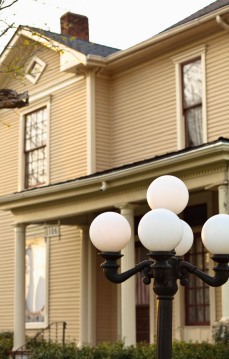By Ken Winter
The central business district of the former Waverly Belmont community emerged in the first quarter of the 20th Century. Previously, farms, estates and enterprises off of Granny White Pike (now 12th Avenue South) were widely spaced, exemplified by the 1852 Sunnyside Greek Revival (in Sevier Park), Becker Farm off the Pike, and the Victorian and Foursquare homes and Schmidt nurseries on Caruthers Avenue. Around 1900 land companies built a streetcar line out the Pike and laid out adjoining subdivisions. By 1920, Belmont Baptist Church (now Belmont Heights on Belmont Blvd.), several commercial buildings, a blacksmith shop and the Clemons Elementary School had joined new houses on Granny White.
 The 1940s were likely the zenith of Waverly Belmont. Charlie Howell III recalls a relatively complex, self-sufficient commercial district – groceries, drugstores, gas stations, ice house, tavern, meat and three, bookstore, in addition to the church and school – serving the growing subdivisions. The known tenants in the still-existing buildings from the period are identified in the attached list of 19 buildings plus one 2010 complementary structure. Many additional business and stories are in Mr. Howell’s reminisces, available from the Metro Nashville Historic Commission and as follows in the link below.
The 1940s were likely the zenith of Waverly Belmont. Charlie Howell III recalls a relatively complex, self-sufficient commercial district – groceries, drugstores, gas stations, ice house, tavern, meat and three, bookstore, in addition to the church and school – serving the growing subdivisions. The known tenants in the still-existing buildings from the period are identified in the attached list of 19 buildings plus one 2010 complementary structure. Many additional business and stories are in Mr. Howell’s reminisces, available from the Metro Nashville Historic Commission and as follows in the link below.
Following a debilitating mid-century emigration to the suburbs, successive alliances of business leaders and residents labored to reinvigorate the community. In September 1957, teachers, parents and students integrated Clemons School. In the ‘70s Sunnyside Neighbors addressed crime and affordable housing. In the ‘90s 1221 and Hawkins Partners, MDHA, and local entrepreneurs developed a thorough-going vision for the blighted community. Joel Solomon and Mark Deutschmann, among others, saw investment as realizing not only financial returns but jobs and community improvement; infrastructure as having physical, technical and personal aspects; and multi-faceted diversity as profound strength.
The new “12South” promise of these social investors is most apparent now in over fifty thriving businesses aged one to seventy, and continues to be conceived, designed and inhabited by locals to complement the old, and sustain the new neighborhood.
Clemons School and Waverly Belmont School
Before Waverly Belmont School was built in 1935, Clemons Elementary (1910) was the civic anchor of the emerging WB Neighborhood. The other cornerstones of this “complete,””walkable” community were affordable Bungalows and Folk Victorians, 12th Avenue dry goods stores, local employment, the 1900 Baptist and 1906 Methodist churches, and the 10th Av tram.
The center of this neighborhood was and is Caruthers Av, the southern border of the soon-to-be-reopened Waverly Belmont School. On Caruthers are rare pre-1900 homes and the 1906 church; within 200 yards are the re-purposed stores, the 1900 church, and vintage homes. Missing only is Clemons School, which was integrated by Pastor Kelly Miller Smith and daughter Joy in the ’60s.
